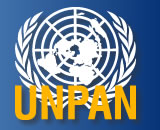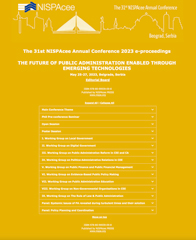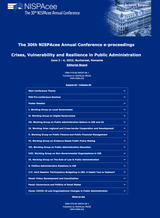Annex 8:
8PR: Introduction of Alternative Forms of Settling Social Conflicts in Regular Practice of Public Authorities
1. Project description
|
Project number |
8PR |
|
Project title |
Introduction of Alternative Forms of Settling Social Conflicts in Regular Practice of Public Authorities |
|
Responsible institution |
|
|
NASPAA partner |
|
|
NISPAcee partner |
Ural Academy for Public Administration, |
|
Budget: planned |
$11,300 USD |
|
Budget: resources really used |
$9,292 USD |
|
Project period: |
1.12.2002 – 25.4.2004 |
2. Project purposes and goals
The main objective of the project was to introduce alternative social dispute resolution in the practice of public authorities by developing a system of training intermediaries at the Specialists Retraining Institute of SAPA. The goals were defined as follows:
1. The main objective of the project is to create an efficient system of training intermediaries for public authorities specializing in “intermediation in a social conflict” at the Specialists Retraining Institute of SAPA.
2. The research objective of the project is twofold. First, there is a need to evaluate the quality of the “Intermediation in a social conflict” educational program from the point of view of its systemic, scientific, comprehensive and practical values. Second, we have to assess the quality of training intermediaries. This is to be done on the basis of a combined assessment comprising the evaluation of knowledge and skills and the appraisal carried out by experts from the appropriate public bodies, as well as by the clients. The results will contribute to the improvement of the curriculum, the enhancement of applied aspects of training and the attainment of the next methodical objective: the development of recommendations to correct the curriculum
3. The methodical objective is to elaborate recommendations to increase the efficiency of the curriculum and to further develop the “Intermediation in a social conflict” specialization.
The following tasks were intended to be solved:
1. To identify professionally and psychologically significant traits of an intermediary and to create a social-psychological image of an intermediary.
2. To carry out trainees’ psychodiagnostics in order to identify their professional fitness for the role of an intermediary.
3. To work out a procedure of selecting specialists applying for the office of an arbitrator, an intermediary or consultant in administrative bodies.
4. To elaborate a set of requirements for professional fitness of an intermediary specializing in “intermediation in a social conflict”.
5. To evaluate the results of training through the assessment of changes in the level of their knowledge, skills, values, attitudes and motivational preferences by using initial and final checks.
6. To elaborate and prepare for publishing “An Intermediary’s Instruction Manual”.
7. To organize a seminar with the assistance of experts from NASPAA and NISPAcee. The workshop will address the topic, “Introduction of alternative forms of disputes resolution in public authorities practice: problems, tasks and prospects”.
8. To prepare for publishing a compendium of project materials comprising the results, participants’ lectures and handouts, intermediary selection procedures and other final documents of the project.
3. Project realization
No major problems occurred during the project realization. The project team cooperated actively with government officials; the project implementation went as planned; and the project timeline was on target. Most team members and other participants actively cooperated in the project and fulfilled their roles and responsibilities. The only problem was the partial commitment of NISPAcee partner Mr. I.A. Kokh in the project. He submitted the materials and papers for teaching aids and the compendium but did not attend the international seminar. He notified the team leader of his failure to come only a few days before the start of the seminar, thus threatening to disrupt some activities of the project.
4. Project outputs, outcomes and impacts
Many tangible outputs result from the project realization, especially:
1. A new curriculum for training labor arbitrators has been developed and revised with due account for specificity of labor authorities’ activities.
2. To identify specific features of labor arbitrators’ activities, a study was carried out by using a “Job analysis” questionnaire and a workplace model was designed.
3. A database of conflict situations (case studies) has been developed.
4. To help attendees with mastering skills in mediation, two teaching manuals have been developed: “Negotiations and intermediation as conflicts resolution technologies” (T. Chernyak and I. Kokh) and “Methods for selecting a mediator” (T. Chernyak).
5. SAPA’s “personnel management” specialization has been enriched by inclusion of a social conflicts resolution section in its curriculum.
The main output of the project was training mediators from among labor specialists engaged in various public authorities. Within the framework of the given project, we involved public servants from Novosibirsk Oblast administration, experts from labor departments and territorial administrations. Training was carried out under the control and supervision of SAPA administration, Specialists Retraining Institute, Skills Improvement Faculty, and was supported by the Oblast administration. The training seminar was organized on the basis of SAPA, in a lecture hall furnished with modern video equipment, an overhead projector and a stereo tape recorder. Training was organized in an active format: role games and case studies accompanied by continuous video recording and analysis of the situations. Lectures were read by teachers of SAPA’s Personnel Management Department under the program, which had been previously agreed upon with the Head of Labor & Employment Department of Novosibirsk Oblast administration. By its structure and content, the seminar was very similar to the program “Intermediation in a social conflict”. Emphasis was placed on conflicts in an organization and their settlement by way of negotiations and intermediation.
Training was completed in two stages:
1)72 hours (March 2003)
2)72 hours (April 2003)
There were 40 attendees: heads of labor units from the territorial administrations and municipalities of Novosibirsk Oblast.
After completing the seminar program and preparing and writing reports, all trainees received a skills improvement certificate.
The project outcomes shall be seen on the level of SAPA and its cooperation with regional governments. The undergraduates of SAPA’s personnel management department have actively participated in the preparation and organization of the seminar for labor arbitrators. They also provided practical assistance in conducting the seminar by playing the roles of supervisors, co-mediators and experts-observers during role games. The students also obtained the skills required to organize training seminars, process the data collected and analyze the results. At the international seminar, one of the students developed a report entitled “Coaching as a means of staff training and development”. They actively participated as organizers and facilitators during the master classes conducted both by Russian trainers and Professor K. Wian.
SAPA and Novosibirsk Regional Administration’s Labor & Employment Department have agreed on:
- an extension of their cooperation in the field of providing permanent consultations on identifying the needs in mediation services at various socio-economic entities
- SAPA’s assistance in creating a social partnership system being developed by the Novosibirsk Regional Administration
- further participation in international projects in order to implement a target program on the establishment of a SAPA-based Conflicts Resolution Center (in much the same way as it was done in the University of Delaware) to provide advice and render assistance in the area of social/labor relations for public authorities.
Relations with large enterprises improved too. For example, Novosibirsk Electric Locomotive Repair Plant agreed to accept SAPA’s students for practical work helping the plant’s personnel department increase the efficiency of human resources development.
Thus, implementing the project allowed us to achieve multiple goals and solve the challenging tasks of enriching the training process with factual data and useful teaching aids and to improve relations with public authorities.




 Price:
Price: 








